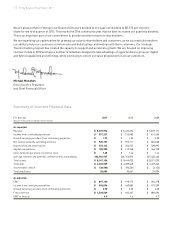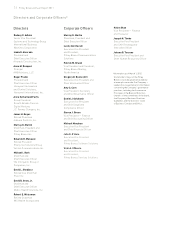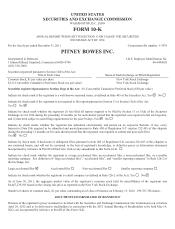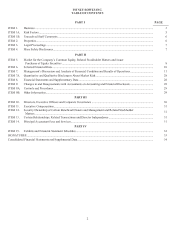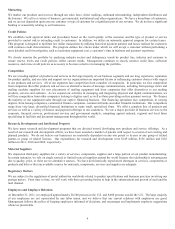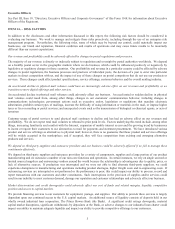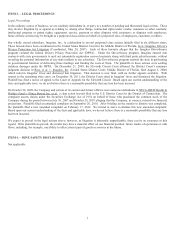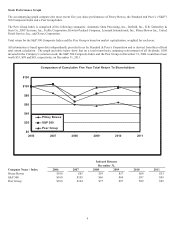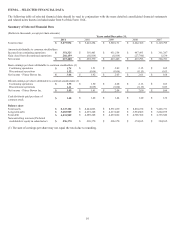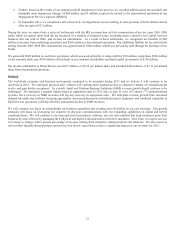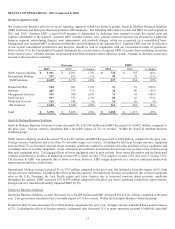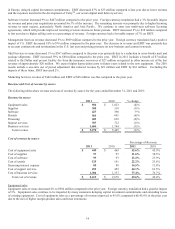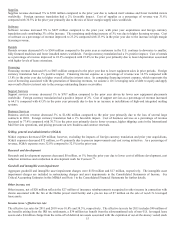Pitney Bowes 2011 Annual Report Download - page 23
Download and view the complete annual report
Please find page 23 of the 2011 Pitney Bowes annual report below. You can navigate through the pages in the report by either clicking on the pages listed below, or by using the keyword search tool below to find specific information within the annual report. 5
Executive Officers
See Part III, Item 10. “Directors, Executive Officers and Corporate Governance” of this Form 10-K for information about Executive
Officers of the Registrant.
ITEM 1A. – RISK FACTORS
In addition to the disclosures and other information discussed in this report, the following risk factors should be considered in
evaluating our business. We work to manage and mitigate these risks proactively, including through the use of an enterprise risk
management program. Nevertheless, the following risks, some of which may be beyond our control, could materially impact our
businesses, our brand and reputation, financial condition and results of operations and may cause future results to be materially
different than our current expectations:
Our revenue and profitability could be adversely affected by changes in postal regulations and processes.
The majority of our revenue is directly or indirectly subject to regulation and oversight by postal authorities worldwide. We depend
on a healthy postal sector in the geographic markets where we do business, which could be influenced positively or negatively by
legislative or regulatory changes in those countries. Our profitability and revenue in a particular country could be affected by adverse
changes in postal regulations, the business processes and practices of individual posts, the decision of a post to enter into particular
markets in direct competition with us, and the impact of any of these changes on postal competitors that do not use our products or
services. These changes could affect product specifications, service offerings, customer behavior and the overall mailing industry.
An accelerated decline in physical mail volumes could have an increasingly adverse effect on our revenues and profitability as we
transition to more digital offerings and other services.
An accelerated decline in physical mail volumes could adversely affect our business. An accelerated or sudden decline in physical
mail volumes could result from, among other things, changes in our customers’ communication behavior, including changes in
communications technologies; government actions such as executive orders, legislation or regulations that mandate electronic
substitution, prohibit certain types of mailings, increase the difficulty of using information or materials in the mail, or impose higher
taxes or fees on mailing or postal services; and unexpected events such as the transmission of biological or chemical agents, or acts of
terrorism
Customer usage of postal services to send physical mail continues to decline and has had an adverse effect on our revenues and
profitability. We do not expect total mail volumes to rebound to prior peak levels. Factors underlying this trend include, among other
things, increasing familiarity and comfort with the Internet, expansion of mobile internet access and the growing trend by businesses
to incent or require their customers to use alternatives to mail for payments and statement presentment. We have introduced various
product and service offerings as alternatives to physical mail; however, there is no guarantee that these product and services offerings
will be widely accepted in the marketplace; and if accepted, they will face competition from existing and emerging alternative
products and services.
We depend on third-party suppliers and outsource providers and our business could be adversely affected if we fail to manage these
constituents effectively.
We depend on third-party suppliers and outsource providers for a variety of components, supplies and a large portion of our product
manufacturing and we outsource a number of our non-core functions and operations. In certain instances, we rely on single sourced or
limited sourced suppliers and outsourcing vendors around the world because the relationship is advantageous due to quality, price, or
lack of alternative sources. If production was interrupted and we were not able to find alternate third-party suppliers, we could
experience disruptions in manufacturing and operations including product shortages, higher freight costs and re-engineering costs. If
outsourcing services are interrupted or not performed or the performance is poor, this could impact our ability to process, record and
report transactions with our customers and other constituents. Such interruptions in the provision of supplies and/or services could
result in our inability to meet customer demand, damage our reputation and customer relationships and adversely affect our business.
Market deteriorations and credit downgrades could adversely affect our cost of funds and related margins, liquidity, competitive
position and access to capital markets.
We provide financing services to our customers for equipment, postage, and supplies. Our ability to provide these services is largely
dependent upon our continued access to the U.S. capital markets. An additional source of liquidity consists of deposits held in our
wholly owned industrial loan corporation, The Pitney Bowes Bank (the Bank). A significant credit ratings downgrade, material
capital market disruptions, significant withdrawals by depositors at the Bank, or adverse changes to our industrial loan charter could
impact our ability to maintain adequate liquidity and impact our ability to provide competitive offerings to our customers.





